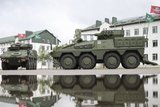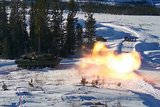DARPA’s GXV-T programme progresses
Several Phase 2 contract awardees of DARPA’s Ground X-Vehicle Technologies (GXV-T) have demonstrated advances on a variety of technologies to meet the programme’s goals, DARPA announced on 22 June.
The GXV-T programme aims to improve mobility, survivability, safety and effectiveness of future combat vehicles without piling on armour. It envisions future combat vehicles that could traverse up to 95% of off-road terrain, including slopes and various elevations.
A team from Carnegie Mellon University National Robotics Engineering Center (CMU NREC) demonstrated the shape-shifting wheel-track mechanisms that transition from a round wheel to a triangular track and back again while the vehicle is on the move, for instant improvements to tactical mobility and manoeuvrability on diverse terrains.
QinetiQ demonstrated an electric in-hub motor approach that incorporates three gear stages and a complex thermal management design into a system small enough to fit a standard military 20-inch wheel rim.
Pratt & Miller’s Multi-mode Extreme Travel Suspension (METS) system aims to enable high-speed travel over rough terrain while keeping the vehicle upright and minimising occupant discomfort. The demonstrator showed off its ability to tackle steep slopes and grades by actively and independently adjusting the hydraulic suspension on each wheel of the vehicle.
Honeywell International demonstrated its windowless cockpit in an all-terrain vehicle (ATV) with an opaque canopy. The 3-D near-to-eye goggles, optical head-tracker and wrap-around Active Window Display screens provide real-time, high-resolution views outside the vehicle. Raytheon BBN Technologies' V-PANE technology fuses data from multiple vehicle-mounted video and LIDAR cameras to create a real-time 3-D model of the vehicle and its nearby surroundings. During the tests, drivers and commanders in a windowless recreational vehicle successfully switched between multiple virtual perspectives to accurately manoeuver the vehicle and detect targets of interest during both low- and high-speed travel.
CMU NREC also demonstrated its Off-Road Crew Augmentation (ORCA) technology that aims to predict in real time the safest and fastest route and when necessary, enable a vehicle to drive itself off-road – even around obstacles. In Phase 2 testing, drivers using the ORCA aids and visual overlays travelled faster between waypoints and eliminated nearly all pauses to determine their routes. The team found autonomy improved either vehicle speed or risk posture and sometimes both.
Maj. Amber Walker, the program manager for GXV-T in DARPA’s Tactical Technology Office, said: ‘DARPA’s excited about the progress made to date on the GXV-T programme and we look forward to working with the services to transition these technologies into ground vehicle technologies of the future.’
More from Land Warfare
-
![Hungary set to begin using Hero 400 loitering munitions]()
Hungary set to begin using Hero 400 loitering munitions
Developed by Israel's Uvision and with systems being sold in the thousands to multiple European NATO countries and the US, the Hero family of loitering systems is also in production in the US and Italy, the latter through Rheinmetall.
-
![Croatia orders Leopards and CAESAR howitzers as Lithuania orders more CAESARs]()
Croatia orders Leopards and CAESAR howitzers as Lithuania orders more CAESARs
The Leopard is becoming the tank of choice in central and eastern Europe as Croatia joins Lithuania, the Czech Republic and Hungary in ordering the platform. Lithuania and Croatia have also signed for CAESAR howitzers.
-
![Light Reconnaissance Strike – enabling a vital mission set (Studio)]()
Light Reconnaissance Strike – enabling a vital mission set (Studio)
A new system-of-systems concept will unlock digital integration of sensors and weapons for Light Forces, allowing them to shape the battlefield environment on their own terms and upgrade legacy platforms.























